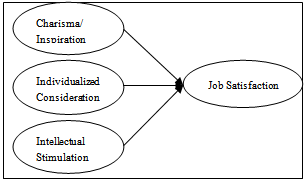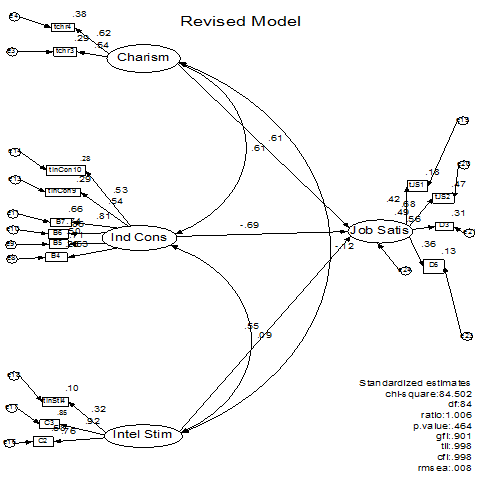-
Paper Information
- Next Paper
- Previous Paper
- Paper Submission
-
Journal Information
- About This Journal
- Editorial Board
- Current Issue
- Archive
- Author Guidelines
- Contact Us
American Journal of Economics
p-ISSN: 2166-4951 e-ISSN: 2166-496X
July, 2012;
doi: 10.5923/j.economics.20120001.32
Transformational Leadership and Job Satisfaction
Jalal R. M. Hanaysha , Khawaja Khalid , Nik Kamariah Nik Mat , Fosa Sarassina , Muhd Yahya Bin Ab Rahman , Ahmad Sazali Bin Zakaria
Othman Yeop Abdullah Graduate School of Business,University Utara Malaysia, Sintok, Kedah, 06010, Malaysia
Correspondence to: Jalal R. M. Hanaysha , Othman Yeop Abdullah Graduate School of Business,University Utara Malaysia, Sintok, Kedah, 06010, Malaysia.
| Email: |  |
Copyright © 2012 Scientific & Academic Publishing. All Rights Reserved.
A vast literature describes transformational leadership in terms of leader having charismatic and inspiring personality, stimulating followers, and providing them with individualized consideration. A considerable empirical support exists for transformation leadership in terms of its positive effect on followers with respect to criteria like effectiveness, extra role behaviour and organizational learning. This study aims to explore the effect of transformational leadership characteristics on followers’ job satisfaction. Survey method was utilized to collect the data from the respondents. The study reveals that individualized consideration and intellectual stimulation affect followers’ job satisfaction. However, intellectual stimulation is positively related with job satisfaction and individualized consideration is negatively related with job satisfaction. Leader’s charisma or inspiration was found to be having no affect on the job satisfaction. The three aspects of transformational leadership were tested against job satisfaction through structural equation modeling using Amos.
Keywords: Transformational, Leadership Charisma, Individualized Consideration, Intellectual Stimulation, Job Satisfaction
Article Outline
1. Introduction
- Organizations are social systems which assume human resources as one of the main factors for achievingcompetitive advantage and influencing organizational effectiveness[1]. Organizations require cooperation among managers and employees for achievement of their goals and objectives. Therefore, the study of employees’ job satisfaction is important in organizational as well as in academic context. Job satisfaction is an important efficiency index for studying organization as satisfaction has a significant impact on employees’ behaviour and work attitude indirectly. Fang, Chang and Chen[2] indicate that job satisfaction has a significant, positive and direct influence on organizational commitment and work performance. Job satisfaction resides from employees’ ability to have a clear understanding of the objectives and the goals of the organization[3]. In Western cultures, job satisfaction comes from the ability of employees to have control over the jobs, or feelings of empowerment in their lives at work[4].Transformational leadership has been of great interest to many researchers in current era andadoptingtransformational leadership behaviour helps in the success of the organization[5]. Transformational leadership takes into account the development and strategic thinking[1], thus enables the organizational change process to happen more rapidly than other leadership styles. Krishnan[6] further explains that transformational leadership enables the creation of value system congruence between the leader and followers, thus facilitating condition where the leader and followers motivate each other to achieve the organizational goals. Doherty and Danylchuk[7] suggest that transformational leadership is of great significance because transformational leadership helps with the increase of satisfaction and commitment of staff through giving impetus and vision. However, some others cast doubt on its application. Due to the extreme importance of job satisfaction and transformational leadership, number of researches was conducted in this topic but there is a limited research available with respect to this topic in Malaysian context. Pihie, Sadeghi and Ellias[8] conducted a research in Malaysian research universities with respect to leadership styles and job satisfaction of academic staff. However, there is limited research conducted for administrative/clerical staff working in different colleges, departments or schools in Malaysian universities. The job satisfaction of administrative /clerical staff is important for uplift of Malaysian universities as they are supposed to attract international students, attain excellence in administrative procedures and plan to achieve high international rankings. Since job satisfaction correlates positively with organizational effectiveness[9], it becomes significantly important to study the job satisfaction level of the university administrative/clerical staff related to the transformational leadership style of concerned department/ school head.
2. Literature Review
2.1. Job Satisfaction
- McShane[10] defines job satisfaction as the individual’s evaluation of his/her own work in terms of the context and content of the work. Job satisfaction of employees often includes such elements as: the job itself, the relationship with the supervisor and co-workers, management beliefs, future opportunity, work environment, and compensation[11]. According to Morris[11], employee job satisfaction is an important factor affecting customer satisfaction.Past studies have used numerous antecedents of job satisfaction other than transformational leadership. For instance, transactional leadership[12], compensation system [13], contingent reward[14], employee empowerment[3], and trust[15]. Most of these antecedents have been found to be positively related with job satisfaction.
2.2. Transformational Leadership
- Bass and Avolio[16] define transformational leadership as the one which helps increasing employees’ concern and strengthening their level of perception as well as their acceptance of the groups’ vision and aims. Transformational leaders facilitate new understandings by increasing or altering awareness of issues. Resultantly, they foster inspiration and excitement in placing extra efforts to achieve common goals[12].Bass[17] proposes that transformational leadership is comprised of charismatic behaviours such as role modeling, risk sharing and attributed charisma. In addition, transformational leadership includes intellectual stimulation consisting of encouraging creativity and change in followers. It also entails the degree to which the leader challenges assumptions, takes risks and solicits followers’ ideas. Finally, individualized consideration which implies leaders paying attention to each follower’s needs and wants by mentoring, supporting, encouraging and coaching followers to use their competence.Riaz and Haider,[12] conducted a study to determine the impact of transformational and transactional leadership style on job success and career satisfaction in context of Pakistan. The results of their study showed that transformational leadership style is positively related to job success and career satisfaction. This finding is consistent with[14],[13] and[3]. They found that transformational leaders had more positive impact on job and overall satisfaction.Furthermore, Lee, Cheng, Yeung and Lai[18] studied the relationships among transformational leadership, team performance and service quality in retail banks, and their findings indicate that among different dimensions of transformational leadership, only intellectual stimulation is significantly related to team leader job satisfaction.Based on above literature review, the following hypotheses are formulatedH1: There is a positive relationship between charisma and job satisfactionH2: There is a positive relationship between individualized consideration and job satisfactionH3: There is a positive relationship between intellectual stimulation and job satisfaction
3. Methodology
- Based on the arguments about the topic, the following research framework is developed for the study.
 | Figure 1. Research Framework |
4. Findings
- A total of 29 items were included in the questionnaire. 23 items measured transformational leadership and 6 items were used as classification questions. We had acceptable Cronbach’s α reliability estimates at 0.833 for Charisma/ Inspiration, 0.840 for Individualized Consideration, 0.710 for Intellectual Stimulation and 0.756 for Job Satisfaction. All results are above the 0.60 cut-off point for internal consistency of the measures[23].The results of CFA for all the constructs provided support for goodness of fit. As far as CFA results for individual constructs were concerned then, for Charisma/ Inspiration, χ2 = 0.766 (p = 0.682), χ2/df = 2.0, Ratio = 0.383, RMSEA = 0, GFI = 0.996; for Individualized Consideration, χ2 = 31.061 (p = 0.054), χ2/df = 20, Ratio = 1.553, RMSEA = 0.076, GFI = 0.922; for Intellectual Stimulation, χ2 = 7.898 (p = 0.019), χ2/df = 2.0, Ratio = 3.949, RMSEA = 0.175, GFI = 0.962; and for Job Satisfaction, χ2 = 6.0 (p = 0.306), χ2/df = 5, Ratio = 1.2, RMSEA = 0.046, GFI = 0.976. We also achieved fit model statistics for our overall model shown in Figure 2 where χ2 = 84.502 (p = 0.464), χ2/df = 1.006, RMSEA = 0.008, GFI = 0.901, TLI = 0.998 and CFI = 0.998.Descriptive statistics reveal that almost 30% of respondents are in age group of 35-40, almost 62% are females, more than 50% are Malaysians and almost 31% have experience of 6 to 10 years and almost 31% respondents have experience of more than 15 years. Table 1 indicates the significant and direction of relationships between different constructs used in study. Intellectual stimulation is found to be significantly related to job satisfaction. However, for individual consideration, the relationship is significant but in the negative direction (p value = 0.042). Thus, this hypothesis is not supported. Charisma is not statistically significant with job satisfaction (p value = 0.107), hence this hypothesis is not supported. Overall, finding of the study leads to the support for hypotheses 3.
|
5. Conclusions
- Positive relationship between intellectual stimulation and job satisfaction shows that result is consistent with[1],[24], and[18]. The hypothesis 2 was not supported as individualized consideration is negatively related to job satisfaction. A possible explanation of this situation could be that employees could not meet their leaders due to leader’s busy schedule leading to lack of individual consideration, thus, the lesser the individual consideration, the higher the job satisfaction. We did not get any support for this finding from past research. As limited studies have been conducted in Malaysia so far, therefore the contextual difference in the culture might be responsible for this new finding. So we suggest conducting more studies in Malaysian context in order to explore this situation. Lastly, the regression weight for charisma and job satisfaction is also positive (0.607) but is not statistically significant. This finding is consistent with Lee et al[18]. Our results are also consistent with the findings of the study conducted by[25] in food and banking sector which found significant positive relationship between intellectual stimulation and job satisfaction but revealed no significant relationship between charisma and job satisfaction. Future researches can study the topic with greater detail by inclusion of certain moderating or mediating variables between transformational leadership in other sectors of Malaysia.
 | Figure 2. Revised Model |
 Abstract
Abstract Reference
Reference Full-Text PDF
Full-Text PDF Full-Text HTML
Full-Text HTML